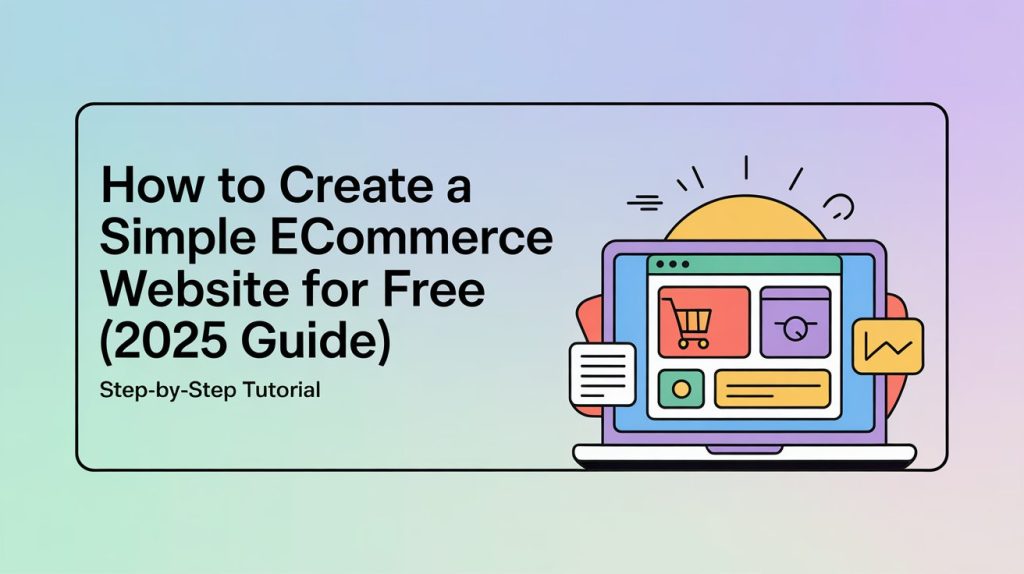Launching your own online store doesn’t have to be expensive or complicated. In fact, in 2025, you can build a simple ecommerce website without spending a single dollar — if you know where to look and how to set it up.
This guide will walk you through every step, from choosing a platform to launching your first free ecommerce store.
Why Start an Ecommerce Website for Free?
Starting for free removes the financial risk. Whether you’re testing a product idea, starting a side hustle, or building your personal brand, a free ecommerce website lets you get online quickly without heavy investments.
Plus, with so many free tools available today, it’s easier than ever to get started.
Is It Really Possible to Launch Without Spending Money?
Yes, but with some limitations.
Free platforms usually offer:
- Limited product listings
- Basic themes
- A subdomain (e.g., yourstore.sitebuilder.com)
Still, if you’re just starting, this is often more than enough. Later, you can upgrade when your business grows.
What You Need Before You Start
Before you dive in, have these basics ready:
1. A Clear Product or Service Idea
Decide what you want to sell: handmade crafts, digital downloads, consulting services, etc.
2. Product Photos and Descriptions
Good images and clear descriptions help customers trust you.
3. Payment Method (Optional)
Even free stores let you connect basic payment options like PayPal or Stripe.
Step 1: Choose a Free Ecommerce Platform
Here are some of the best free ecommerce platforms in 2025:
– Square Online
Great for physical products and offers a free online store plan.
– Ecwid
Lets you add a free store to any existing website.
– Big Cartel
Perfect for artists or small sellers; free plan supports up to 5 products.
– Shopify Starter
A simplified (and almost free) version, though after trial it costs a few dollars.
Pros and Cons
| Platform | Pros | Cons |
|---|---|---|
| Square Online | Easy setup, no upfront cost | Limited design customization |
| Ecwid | Add store to existing site | Free plan has product limits |
| Big Cartel | Ideal for artists, simple | Max 5 products on free plan |
| Shopify Starter | Professional feel | Trial, then small cost |
Step 2: Create a Free Account
Once you pick a platform:
- Go to the official website
- Sign up using your email
- Choose “Free” or “Starter” plan
- Follow the setup wizard to name your store
Tip: Choose a simple, memorable store name that reflects your brand.
Step 3: Design Your Ecommerce Website
Most free platforms offer ready-made templates. Here’s how to customize yours:
1. Pick a Template
Choose a design that matches your product style (e.g., minimal for jewelry, bold for tech gadgets).
2. Customize Colors and Fonts
Stick to 2-3 brand colors and 1-2 fonts for a clean, professional look.
3. Add a Logo
You can create a free logo using tools like Canva if you don’t have one.
Step 4: Add Your Products
Now it’s time to fill your store:
1. Upload High-Quality Images
Use natural lighting, clean backgrounds, and multiple angles.
2. Write Clear Product Descriptions
Answer common customer questions:
- What is it made of?
- How big is it?
- How does it work?
3. Set Prices
Research competitors to price your items competitively.
Step 5: Set Up Payment Methods
Most free platforms let you accept:
- PayPal
- Stripe (Credit/Debit Cards)
Tip:
Make sure your payment setup is working correctly. Place a test order if the platform allows.
Step 6: Configure Shipping Settings
Decide how customers will receive your products:
Options:
- Free Shipping: Great for marketing (“Free shipping on all orders!”)
- Flat Rate Shipping: Simple pricing, like $5 shipping anywhere.
- Local Pickup: Good for selling locally.
Set clear shipping expectations to avoid confusion.
Step 7: Launch Your Store
Almost there!
Before you launch:
- Test checkout process
- Check mobile responsiveness
- Proofread all pages
- Add basic legal pages (Privacy Policy, Terms)
Then:
Hit “Publish” and your store goes live!
Bonus Tips
How to Get a Free Domain Name
Some platforms give a free subdomain (e.g., yourshop.square.site).
If you want a custom domain (e.g., yourshop.com), services like Freenom offer free domains — but quality and trust can vary.
How to Promote Your Store for Free
- Share on social media (Instagram, Facebook, Pinterest)
- Join online communities (Facebook Groups, Reddit)
- Start a free blog about your products
- Collect emails from day one for free email marketing later
Common Mistakes to Avoid
- Ignoring Mobile Optimization: Over 60% of online shopping happens on mobile.
- Too Many Products: Start with 5-10 focused items.
- Weak Product Descriptions: Avoid copying others; Google hates duplicate content.
- No Marketing Plan: You won’t get sales just by publishing — promote your store actively!
Conclusion
Starting a free ecommerce website in 2025 is 100% possible — and smart.
While there are a few limitations, it’s the perfect way to validate your business idea before investing real money.
As your store grows, you can move to a paid plan to unlock more features like better designs, more products, and marketing tools.
Want a fully developed websit: Contact Us Now
Ready to launch your store today? Start small, think big, and watch your business grow! 🚀
Visit Our New Blog Website: Study Masti
📋 Quick FAQ
Q1: What is the best free ecommerce platform for beginners?
A: Square Online is great for beginners — easy setup and no upfront costs.
Q2: Can I make a professional-looking store for free?
A: Absolutely! Free templates today are much better than they used to be. With good photos and clean design, your store can look amazing.
Q3: Do free stores make real sales?
A: Yes! Many entrepreneurs started with free stores and scaled up once they gained traction.

